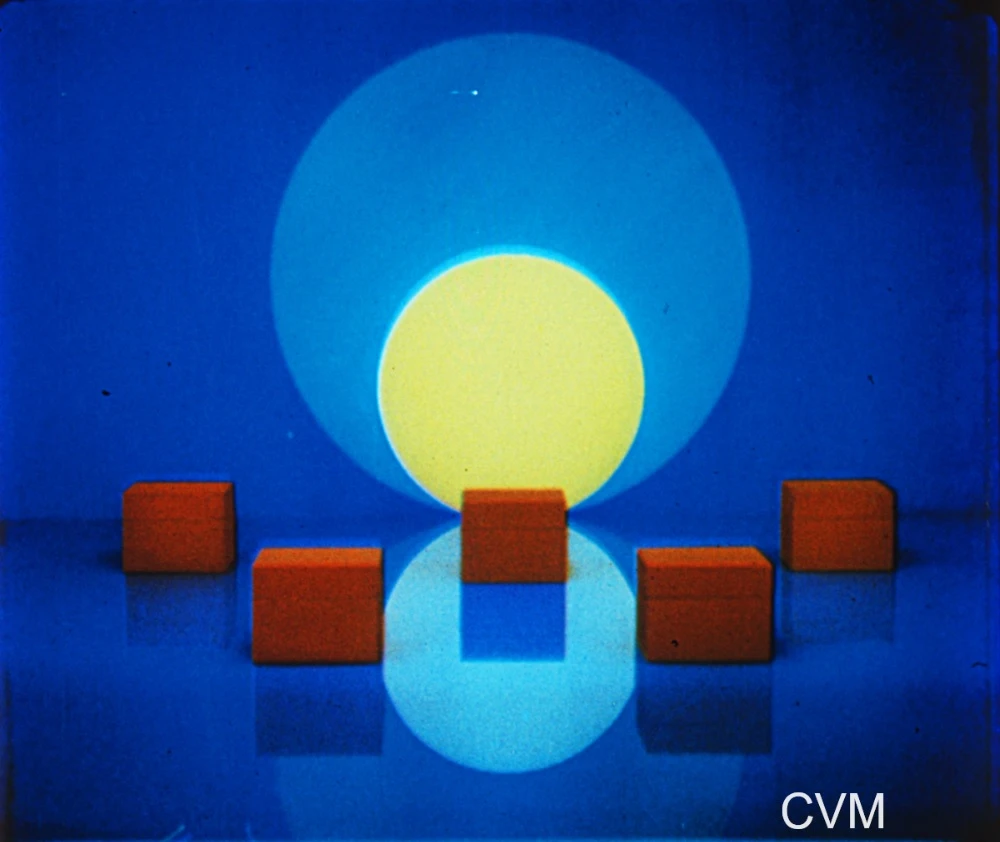
Oskar Fischinger, Komposition in Blau (Composition in Blue), film, 1938. Courtesy of the Center for Visual Music
Held on 01, 15 jun 2025
Moon Projector is the Museo Reina Sofía’s regular film programme for young audiences. Every Sunday morning, sessions are held to introduce children to cinema and audiovisual arts, taking them on a journey of fascination, where imagination and knowledge abound, from the dawn of film language to today’s most creative and original works with future generations in mind. The programme title draws from the work of poet Federico García Lorca, a Moon Projector where dreams and early imagination reverberate, and where children’s fantasy emerges from the contemplation of projected light.
Dancing Forms takes us into the genesis of animation, into the fascinating worlds of early footage of moving forms and colour in film. These principles denoted the first filmic experience of animated cinema, in this case through the basic forms of art that inspired experimental creation, as well as an approach to primitive imagery. This visual and sound experience seeks to explore the sensory world of child contemplation — a journey of forms, colours, sound and different music which spark children’s curious gaze. A new world without identity figures or predictable narratives, where the youngest children can directly experience moving forms and colours.
The artists and film-makers who accompany us on this voyage include some of the pioneers from the historical avant-garde and key artists in the mid-twentieth century. The session is structured around Oskar Fischinger (Germany,1900 – USA,1967), one of the grand masters of animation by way of the experimental montage of sounds and images; Len Lye (New Zealand, 1901 – USA, 1980), a reference point in experimental animation in the first half of the twentieth century via the innovative fusion of sounds, such as Latin rhythms, mambo and swing, and abstract forms; Mary Ellen Bute (USA,1906–1983), one of the first women experimental film-makers with a work which pivots around synaesthesia, music turned into images; Norman McLaren (Scotland, 1914 – Canada, 1987), undoubtedly one of the most relevant artists in the creation of graphic-sound animations; and finally Faith Hubley (New York, 1924–2001), an artist behind evocative abstract films that evolved from primitive forms to narrative figuration.
Organised by
Museo Reina Sofía
Accessible activity
This activity has a place for people with reduced mobility.
Programme
Oskar Fischinger. Studie Nr. 7 (Study No. 7)
Germany, 1931, digital archive, black and white, sound, 3’. Courtesy of the Center for Visual Music
White lines and forms on a black background, moving to the rhythm of Brahms Hungarian Dance No. 5.
Oskar Fischinger. Komposition in Blau (Composition in Blue)
Germany, 1938, digital archive, colour, sound, 4’
Courtesy of the Center for Visual Music
Various cubes move in sync to the rhythm of music, transforming into circular figures which disappear in a false blue that turns red.
Len Lye. Kaleidoscope
UK, 1935, DCP, colour, sound, 4’
To joyous mambo music, the typical geometries of kaleidoscopes move and break to the rhythm of the notes.
Len Lye. Colour Flight
UK, 1938, DCP, colour, sound, 4’
Forms and lines dance to the joyous notes of mambo and swing.
Mary Ellen Bute. Tarantella
USA, 1940, DCP, colour, sound, 4’35”
To the notes of composer Edwin Gerschefski, different forms and lines metamorphose into other unexpected and harmonious elements.
Norman McLaren. Blinkity Blank
Canada, 1955, DCP, colour, sound, 5’
On a black background flashes appear like fireworks, to the pattern of free sounds.
Norman McLaren. Le merle (The Blackbird)
Canada, 1958, DCP, colour, sound, 5’
Reinterpreting the rhythm of a popular French-Canadian song, lines and circles transform into a moving bird.
Faith Hubley. Tall Time Tales
USA, 1992, digital archive from 16 mm, colour, sound, 8’
Basic elements from nature shape primitive forms to the sound of notes from African and tantric rhythms. Biomorphism plays with figuration to tell us the story of life.
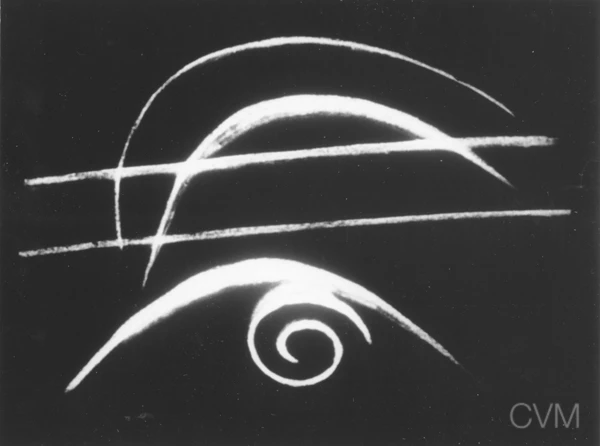
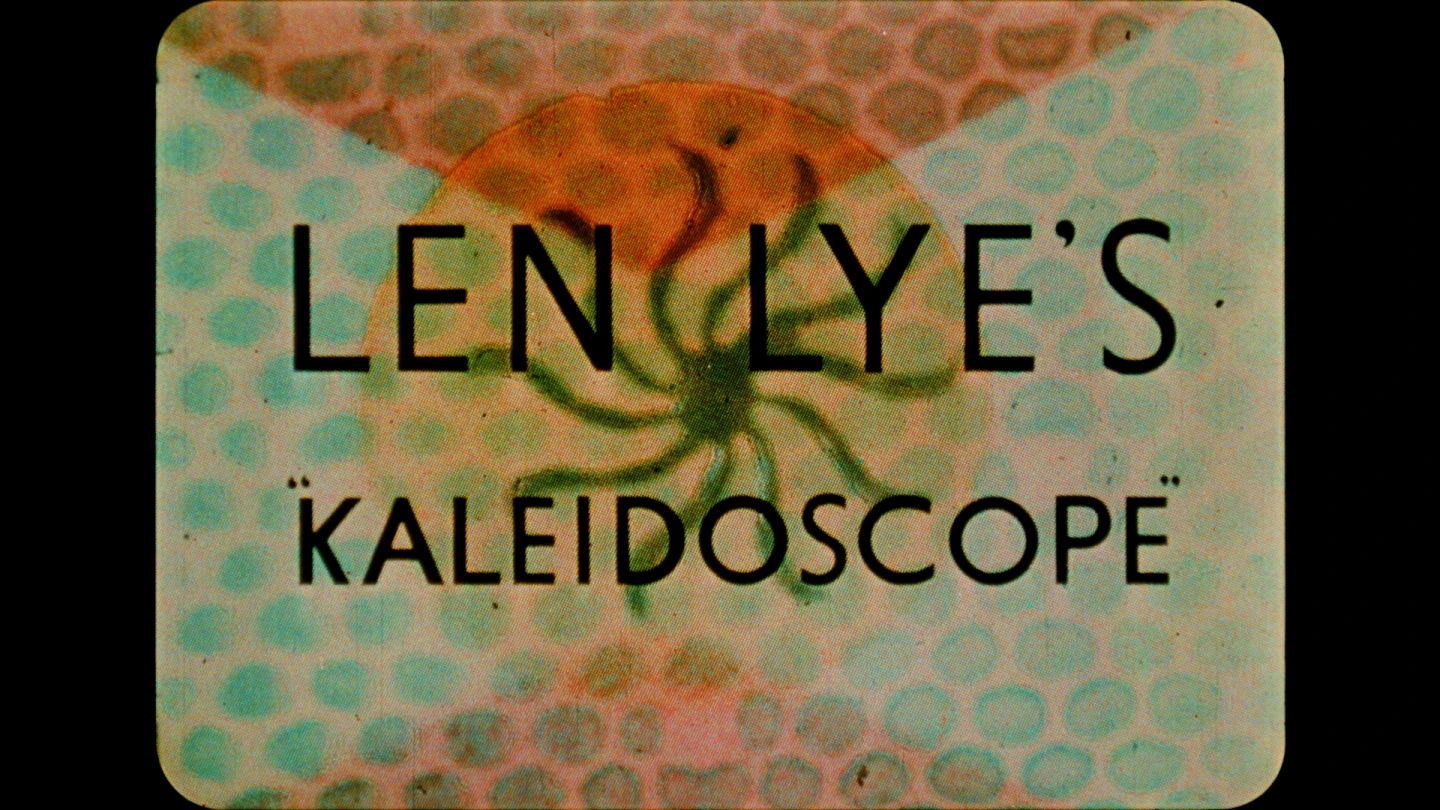
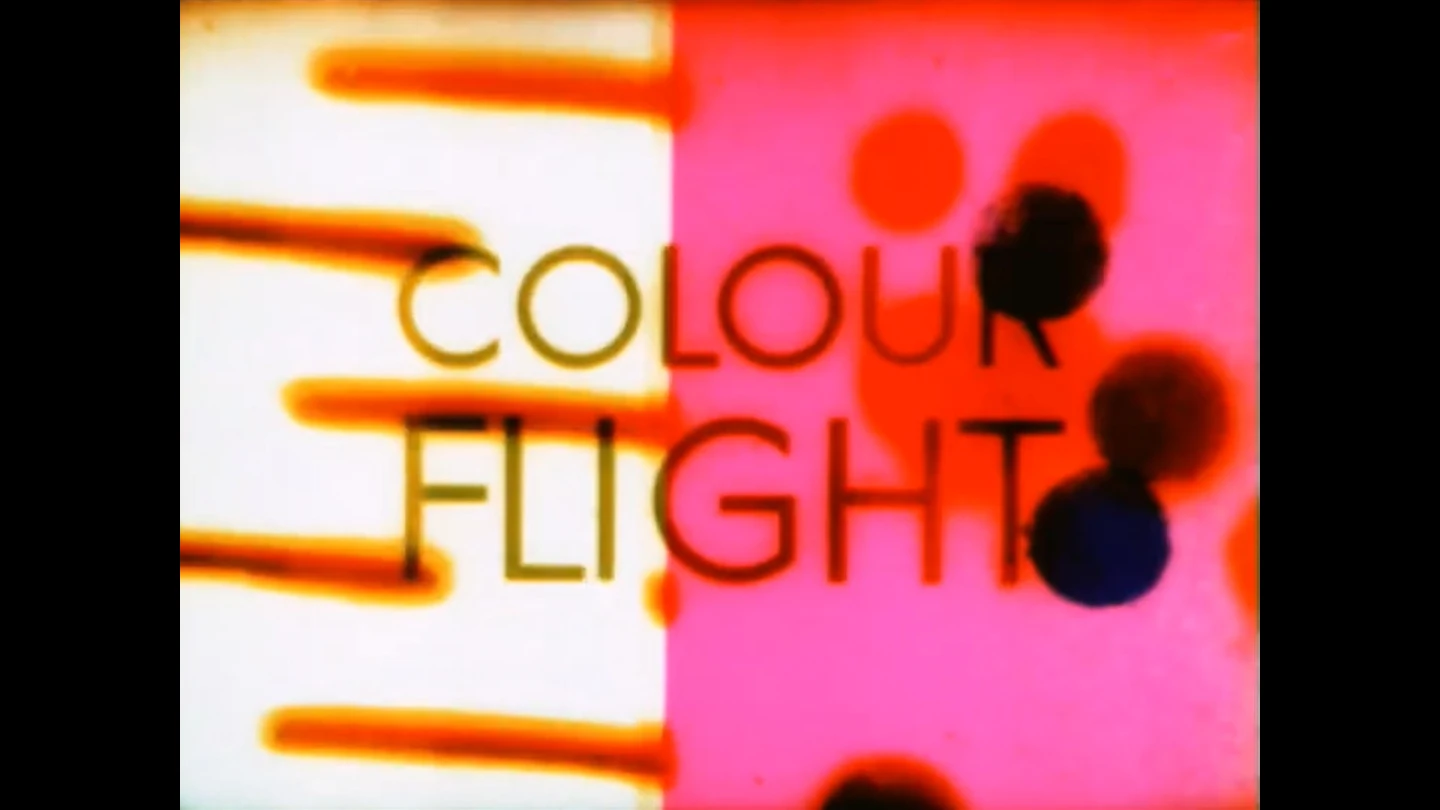

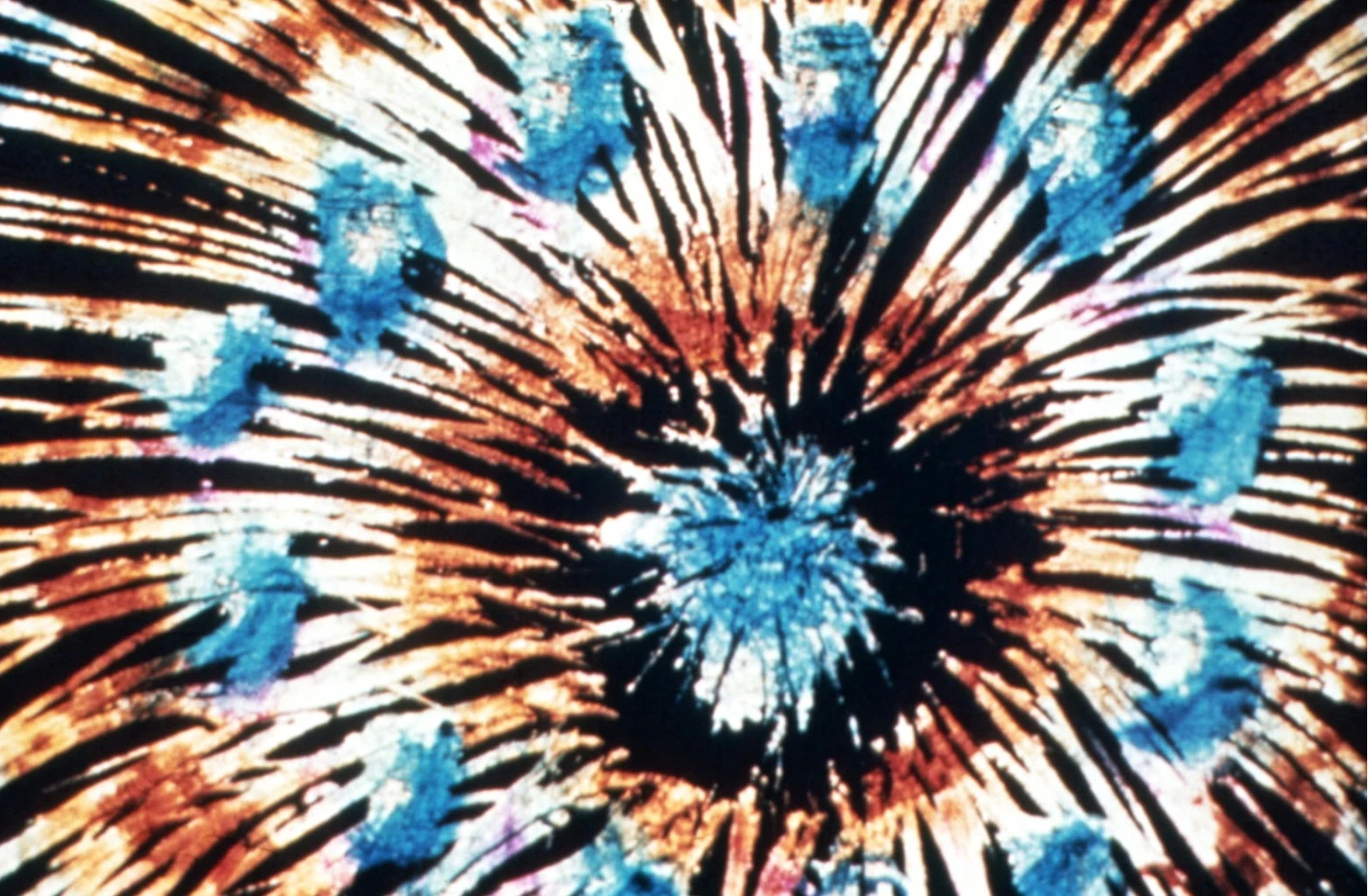
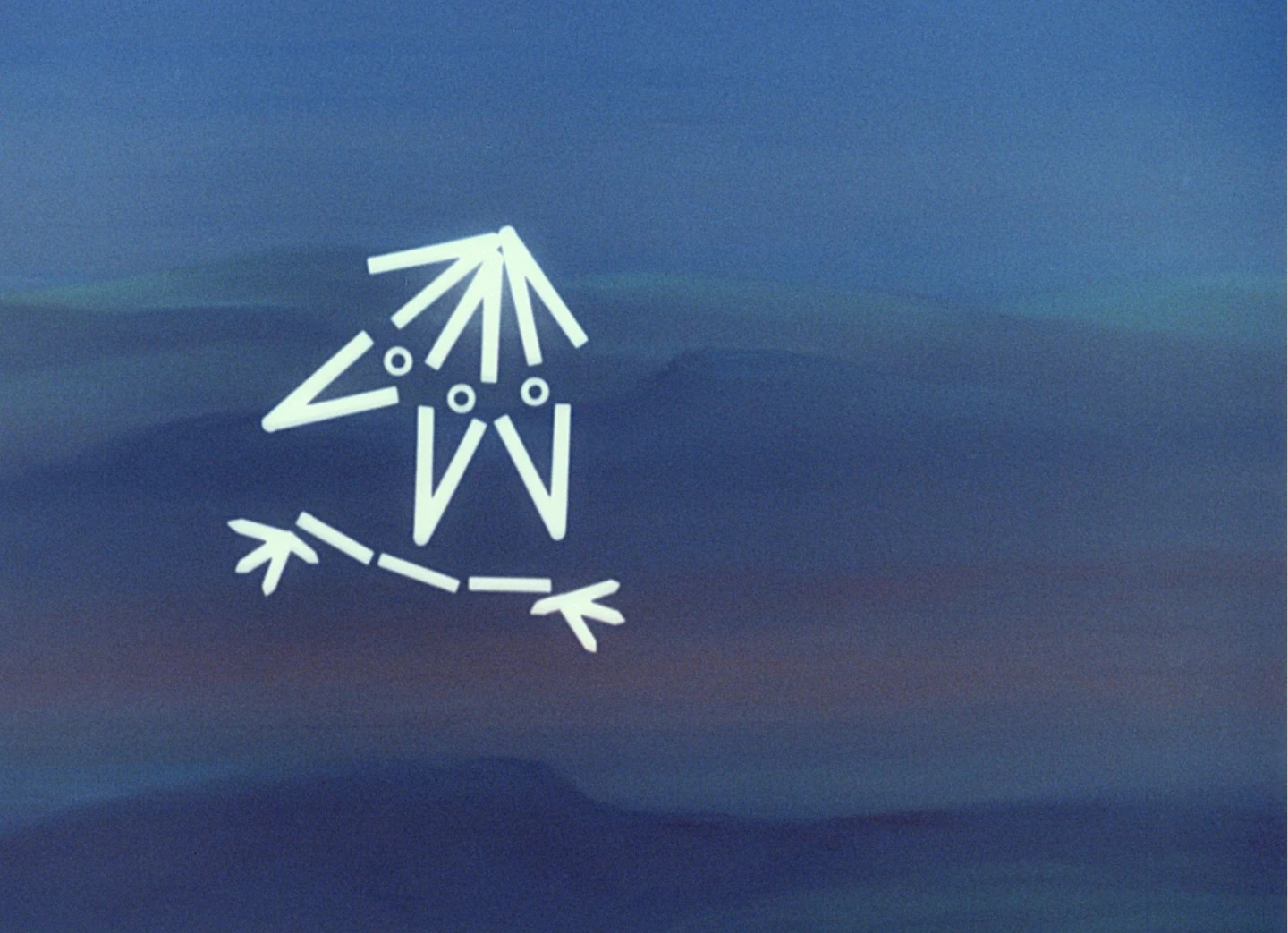
Más actividades
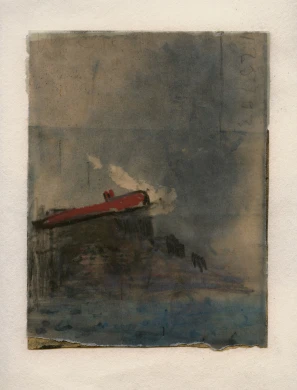
Juan Uslé. That Ship on the Mountain
Tuesday, 25 November 2025 – 7pm
Ángel Calvo Ulloa, curator of the exhibition Juan Uslé. That Ship on the Mountain, engages in conversation with artist Juan Uslé (Santander, 1954) in the Museo’s Auditorium 400 to explore in greater depth the exhibition discourse of this anthological show spanning four decades of Uslé’s artistic career.
The show casts light on the close relationship Uslé’s work bears to his life experiences, establishing connections between different stages and series which could ostensibly seem distant. Framed in this context, the conversation looks to explore the artist’s personal and professional journey: his memories, experiences of New York, his creative process, conception of painting, and ties with photography and film, and the cohesiveness and versatility that characterise his art. Key aspects for a more in-depth understanding of his artistic sphere.
The conversation, moreover, spotlights the preparatory research process that has given rise to this exhibition to grant a better understanding of the curatorial criteria and decisions that have guided its development.
These inaugural conversations, part of the main working strands of the Museo’s Public Programmes Area, aim to explore in greater depth the exhibition narratives of the shows organised by the Museo from the perspective of artists, curators and specialists.

Fifteenth Edition of the Márgenes Festival
Sunday, 23 November 2025 - 7:30pm
This year’s opening night of the fifteenth edition of the Márgenes International Contemporary Film Festival will take place inside the Museo Reina Sofía. The inaugural session will witness artists Neutro Gris and Nodoaviom perform, live and for the first time, the multimedia performance Music 4 Salvation, which extends their language towards a sensorial experience fusing sound, image and digital emotion.
Music 4 Salvation unfolds as a sound and visual collage in which different strands are linked in one sole narrative of youth and adulthood, notions from which the piece puts forward a second reading of popular symbology and iconography and culminates by evoking the transitional time between these two stages of life. And all from a post-internet gaze and found footage aesthetics.
The Márgenes Festival is held from 23 to 30 November in Madrid and shines a light on innovative initiatives that combine up-and-coming and acclaimed talent. Its film programme explores the convergence of cinema, the visual arts and sound art with approaches that expand the limits of the film experience, encompassing screenings, audiovisual shows, performances, encounters and sessions for children. In addition to the opening event, the Museo also welcomes, among the organised activities this year, the series Emotional Interface. The Films of Metahaven.

The Films of Ira Sachs
From Thursday, 20, to Sunday, 23 November 2025 – Check times
The International Festival of LGBTQIA+ Cinema in Madrid (QueerCineMad) and the Museo Reina Sofía come together to organise a retrospective on Ira Sachs (USA, 1965), a pivotal film-maker in contemporary queer cinema whose work has charted, across three decades, the affects, losses and resistance that traverse the lives of the LGBTQIA+ community. Sachs is the creator of a filmography which conceives of New York as the emotional architecture of his narratives, and as a space of memory, struggle and community. This programme includes the premiere of his most recent film, Peter Hujar’s Day (2025), in Madrid, with the film-maker in attendance in three of its sessions.
Sachs has filmed, with delicacy and conviction, the tensions between desire, precarity and belonging, from his first feature-length film, The Delta (1996), set on the margins of the Mississippi, to Love Is Strange (2014), where a gay couple have to give up their Manhattan apartment after marrying. In Keep the Lights On (2012) intimacy becomes a battleground in confronting addiction and neglect, while Lady (1994), a short film on the solitude of an elderly woman in New York, anticipates his sensibility for bodies made invisible. Last Address (2010) is a silent homage to queer artists who died from AIDS/HIV-related illnesses — Robert Mapplethorpe, Keith Haring, David Wojnarowicz — whereby the façades of the buildings they lived in become intimate monuments, the remnants of history erased through windows. Thus, Ira Sachs’s body of work engages in a profound dialogue with film-makers such as Rainer Werner Fassbinder in situating the gaze at the centre of bodies, in exploring the complexity of the struggle between himself and his films. Further, his practice reverberates through New Queer Cinema, a 1990s film movement that transformed the representation of sexuality from difference.
The director’s presence in Madrid, coupled with the premiere of his new work, makes this film season an event which extols both his career and his form of gazing and inhabiting the city from the queer, the community and the poetic. In these times of eviction and urban homogenisation, Sachs’s film-making reminds us that the neighbourhood can also be a gesture of care, a form of resistance, a future promise.
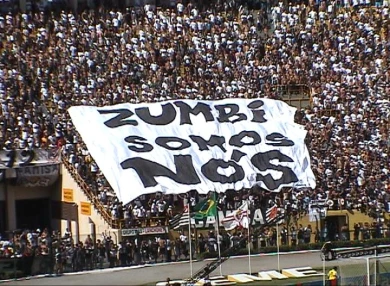
The History and Roots of Samba
Saturday, 22 November 2025 – 6pm
Museo Situado and the Maloka Brazilian Cultural Association come together to offer this artistic, historical and social activity in conjunction with Black Consciousness Day in Brazil, which pays homage to Dandara and Zumbi dos Palmares, universal symbols of Afro-Brazilian resistance and the fight against slavery.
In the activity, dance, poetry and performance become tools of memory and resistance via a programme which surveys the history of samba, from its origins in Bahia to its consolidation in Rio de Janeiro. It features the participation of more than ten Brazilian artists and pays homage to key figures in samba such as Tia Ciata, Clementina de Jesús, Cartola, Dona Ivone Lara, Elza Soares, Martinho da Vila and Alcione.
Further, the event seeks to shine a light on the richness of Afro-Brazilian culture while opening a space of reflection on resistance to racism throughout history and today, as well as inequality and disregard. In the words of philosopher Sueli Carneiro (2000), “the fight for the rights of black women and the community of African descent is inseparable from the rescue of history and the memory of our ancestors”. It is an artistic and vindicatory celebration that invites the whole community to aquilombarse: to come together, celebrate and affirm collective memory, for, as sociologist Florestan Fernandes (1976) affirmed, “the history of peoples of African descent can only be understood through the active resistance to oppression”. Long live Dandara. Long live Zumbi. Long live Afro-Brazilian ancestry.
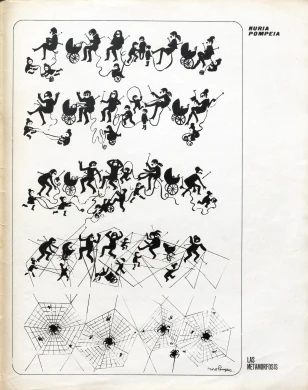
Crossed Vignettes
Friday, 21 November 2025 – Check programme
The Crossed Vignettes conference analyses the authorship of comics created by women from an intergenerational perspective and draws from the Museo Reina Sofía Collections. Across different round-table discussions, the programme features the participation of illustrators Marika, Carla Berrocal, Laura Pérez Vernetti and Bea Lema and researchers Viviane Alary, Virginie Giuliana and Elisa McCausland.
The aim of the encounter is twofold: to explore in greater depth the different forms in which women comic book artists have contributed to developing a counterculture; namely, the appearance of ruptures, reformulations and new genres within the ninth art. And to set up a dialogue which ignites an exploration of genealogies linking different generations of artists.
Moreover, the activity is put forward as a continuation to the exhibition Young Ladies the World Over, Unite! Women Adult Comic Book Writers (1967–1993) and the First International Conference on Feminist Comic Book Genealogies, held in April 2024 at the Complutense University of Madrid.
In redefining the visual narratives of the comic book and questioning gender stereotypes in a male-dominated world, women comic book writers and artists have impelled greater visibility and a more prominent role for women in this sphere. The study of intergenerational dialogue between female artists past and present enables an analysis of the way in which these voices reinterpret and carry the legacy of their predecessors, contributing new perspectives, forms of artistic expression and a gender-based hybridisation which enhances the world of comics.
The conference, organised jointly by the Museo Reina Sofía and Université Clermont Auvergne/CELIS (UR4280), features the participation of the Casa de Velázquez and is framed inside the context of the CALC programme The Spanish Artistic Canon. Between Critical Literature and Popular Culture: Propaganda, Debates, Advertising (1959–1992), co-directed by Virginie Giuliana. It is also the outcome of the projects Horizon Europa COST Actions iCOn-MICs (Comics and Graphic Novels from the Iberian Cultural Area, CA19119) and COS-MICs (Comics and Sciences, CA24160).



![Miguel Brieva, ilustración de la novela infantil Manuela y los Cakirukos (Reservoir Books, 2022) [izquierda] y Cibeles no conduzcas, 2023 [derecha]. Cortesía del artista](https://recursos.museoreinasofia.es/styles/small_landscape/public/Actividades/ecologias_del_deseo_utopico.jpg.webp)
![Ángel Alonso, Charbon [Carbón], 1964. Museo Reina Sofía](https://recursos.museoreinasofia.es/styles/small_landscape/public/Actividades/perspectivas_ecoambientales.jpg.webp)